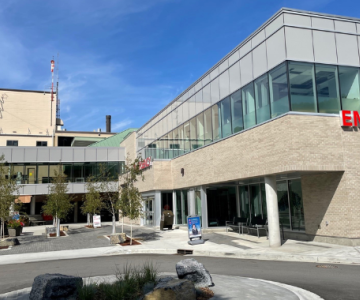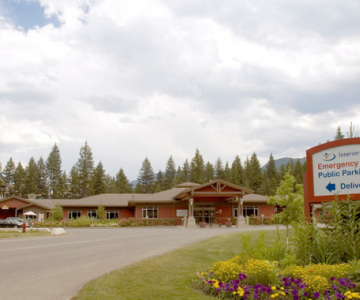1 Minute Read
Public Service Announcement
People who use Royal Inland Hospital (RIH) are advised of changes to the way they access the Kamloops hospital, beginning Monday, July 18 with the opening of the Phil & Jennie Gaglardi Tower.
The public will now access the main entrance and the emergency department in a new way.
Main entrance and patient drop off
The new main entrance and patient drop-off area is located at the front doors of the Gaglardi Tower, across from the Clinical Services Building (CSB) parkade. Public parking remains in the CSB parkade and people can walk from Level P4 of the CSB parkade and follow the sidewalk to access the main entrance to RIH.
Emergency entrance
The new, permanent emergency entrance at RIH is located at the roundabout (near the old coffee shop). There is no longer any emergency parking near the ambulance bay. Short-term public parking for the emergency department is now located on the right side of the drive leading to the roundabout. Signage will be in place to help guide patients.
View parking map
1 Minute Read
Public Service Announcement
TRAIL – People who rely on Kootenay Boundary Regional Hospital (KBRH) in Trail are advised that the main and emergency department public entrances will be closed for three weeks beginning July 11.
Construction crews will be working on enhancing the entrance access to the regional hospital.
To allow for the construction, patients and visitors will be directed to the ambulance bay entrance at KBRH.
The bus stop will be temporarily relocated closer to the interim entrance and greeters will be in specific locations to help assist people accessing the hospital. Signage will also be in place.
Interior Health regrets any inconvenience to people while this work is taking place.
1 Minute Read
News Release
A new pharmacy at Kootenay Boundary Regional Hospital is now open, offering enhanced operational efficiency, improved working conditions and modern technology.
Read the full release
1 Minute Read
Public Service Announcement
CLEARWATER - Clearwater and area residents are advised of a temporary change to the emergency department hours at Dr. Helmcken Memorial Hospital tonight due to limited staffing availability.
The emergency department will be closed:
6 p.m. Thursday, July 7 to 7 a.m. Friday, July 8
Full service will resume on Friday, July 8 at 7 a.m.
Interior Health regrets this temporary change to normal operations and reminds residents to take note of the following if they require care while the emergency department is closed:
In the event of an emergency, call 911.
Visit the emergency department at one of the following facilities:
Royal Inland Hospital – 311 Columbia Street, Kamloops
Call HealthLink BC at 8-1-1 (24 hour service) if you are unsure of your need to seek emergency care.
The emergency department in Clearwater is normally open 24/7.
1 Minute Read
Public Service Announcement
MERRITT – Merritt and area residents are advised that the emergency department at Nicola Valley Hospital will be closed 8 a.m. July 4 until 8 a.m. July 5, due to limited physician availability.
Interior Health regrets this temporary change to normal operations and reminds residents to take note of the following if they require care while the emergency department is closed:
In the event of an emergency, call 911.
Visit the emergency department at one of the following facilities:
Royal Inland Hospital – 311 Columbia Street, Kamloops
Kelowna General Hospital – 2268 Pandosy Street, Kelowna
Call HealthLink BC at 8-1-1 (24 hour service) if you are unsure of your need to seek emergency care.
Interior Health apologizes for this temporary interruption to normal services.
1 Minute Read
Public Service Announcement
Clearwater and area residents are advised of a temporary change to the emergency department hours at Dr. Helmcken Memorial Hospital due to limited staffing availability.
The emergency department will be closed:
8 a.m. Saturday, July 2 to 8 a.m. Sunday, July 3
Full service will resume on Sunday, July 3 at 8 a.m.
Interior Health regrets this temporary change to normal operations and reminds residents to take note of the following if they require care while the emergency department is closed:
In the event of an emergency, call 911.
Visit the emergency department at one of the following facilities:
Royal Inland Hospital – 311 Columbia Street, Kamloops
100 Mile House General Hospital – 555 Cedar Ave South
Call HealthLink BC at 8-1-1 (24 hour service) if you are unsure of your need to seek emergency care.
The emergency department in Clearwater is normally open 24/7.
1 Minute Read
Public Service Announcement
Clearwater and area residents are advised of a temporary change to the emergency department hours at Dr. Helmcken Memorial Hospital tonight due to limited staffing availability.
The emergency department will be closed:
6 a.m. to 7 p.m. Thursday, June 30
Full service will resume on Thursday, June 30 at 7 p.m.
Interior Health regrets this temporary change to normal operations and reminds residents to take note of the following if they require care while the emergency department is closed:
In the event of an emergency, call 911.
Visit the emergency department at one of the following facilities:
Royal Inland Hospital – 311 Columbia Street, Kamloops
Call HealthLink BC at 8-1-1 (24 hour service) if you are unsure of your need to seek emergency care.
The emergency department in Clearwater is normally open 24/7.
4 Minute Read
Information Bulletin
Environment and Climate Change Canada has issued special weather statements for several parts of the province, with daytime temperatures in the Interior ranging from the low to mid 30s. This is not a heat warning or an extreme heat emergency, but we will experience the first high temperatures of the summer. The warmer weather will also cause rapid snow melt, leading to high rivers and streams throughout the province so please keep water safety in mind this weekend.
The first high temperatures of the season can lead to some people overheating because they are not yet acclimatized to warmer weather. There are some basic steps you can take to ensure you and your family remain safe and healthy during warmer temperatures.
Additional heat information is available on the Interior Health public website. The BC Centre of Disease Control (BCCDC) also has a broad range of heat-related information on its website, including information on the different types of heat alerts, how to prepare for warmer temperatures, symptoms of heat-related illnesses, those most at risk during warmer weather, and ways to stay cool.
Preparing for hot weather:
Identify a cooler space in your home and prepare it so you can stay there at night, if possible. You may need to change daily living arrangements.
Find an air-conditioned spot close by where you can cool off on very hot days. Consider staying with friends or family or find places in your community to spend time such as movie theatres, libraries, community centres, or shopping malls.
Check that you have a working fan. If you have an air conditioner, make sure it works.
Install awnings, shutters, blinds, or curtains over your windows to keep the sun out during the day.
Practice opening doors and windows to move cool air in at night and shutting windows during the day to prevent hot outdoor air from coming inside.
Get a digital room thermometer to keep with you so you know when your home is getting too hot.
Who is most at risk?
It is important to monitor yourself and family members, and to consider developing a check-in system for neighbours and friends who are at higher-risk during warmer weather
The most susceptible individuals include:
Older adults, especially those over 60
people who live alone
people with pre-existing health conditions such as diabetes, heart disease or respiratory disease
people with mental illnesses such as schizophrenia, depression, or anxiety
people with substance use disorders
people with limited mobility
people who are marginally housed
people who work in hot environments
people who are pregnant
infants and young children
Your health:
Spray your body down with water, wear a damp shirt, take a cool shower or bath, or sit with part of your body in water to cool down if you are feeling too hot.
Drink plenty of water and other liquids to stay hydrated, even if you are not feeling thirsty
Take it easy, especially during the hottest hours of the day.
Stay in the shade and use a broad spectrum sunscreen with SPF 30 or more.
Signs of overheating include feeling unwell, headache, and dizziness. Take immediate action to cool down if you are overheating.
It is important to remember that overheating can lead to heat exhaustion and heat stroke.
Signs of heat exhaustion include heavy sweating, severe headache, muscle cramps, extreme thirst, and dark urine. If you are experiencing these symptoms, you should seek a cooler environment, drink plenty of water, rest, and use water to cool your body.
Heat stroke is a medical emergency
In the event of a medical emergency, British Columbians are advised to call 9-1-1. However, it is also important to use 9-1-1 responsibly to avoid overwhelming the system.
BC Emergency Health Services in partnership with ECOMM is reminding British Columbians to only dial 9-1-1 for serious or life-threatening injuries
When to call 9-1-1:
In general: when there is chest pain, difficulty breathing, loss of consciousness, severe burns, choking, convulsions that are not stopping, a drowning, a severe allergic reaction, a head injury, signs of a stroke, a major trauma.
More specifically related to hot weather: severe headache, confusion, unsteadiness, loss of thirst, nausea/vomiting, and dark urine or no urine are signs of dangerous heat-related illness.
If you have a less urgent health issue:
You can call 8-1-1 and get connected with a nurse at HealthLinkBC. Or, if you can do it safely, you could go to an urgent care centre or clinic.
That way, our highly trained emergency medical dispatch staff and paramedics will be available for people who need their services the most.
There are also online tools at healthlinkbc.ca including a “Check Your Symptoms” tool.
While this bulletin is about the beginning of hot summer weather, additional information on preparing for extreme heat events can also be found in BC’s Extreme Heat Preparedness Guide.
2 Minute Read
News Release
A mobile phone app launched two years ago has continued to gain popularity among people who use drugs and those who support them, and is successfully preventing toxic drug deaths in B.C.
“The Lifeguard Digital Health App has a proven track record of keeping people safe and is an important part of our government’s response to the toxic, unpredictable illicit drug supply,” said Minister of Mental Health and Addictions Sheila Malcolmson.
Since its launch in May 2020, the app has been used by more than 9,000 people in B.C. There have been 104,783 sessions, resulting in 132 ambulance calls with 96 “confirmed ok” call backs to the app user. There have been 28 drug poisonings reversed and, most importantly, there have been zero deaths reported by Lifeguard.
In Interior Health there were 12,084 sessions (May 2020 – May 2022) including 14 ambulance calls. In April 2022, there were 422 sessions within Interior Health.
“There are many reasons why people use substances alone,” said Interior Health president and CEO Susan Brown. “The stigma surrounding substance use is one of the main reasons. While we encourage people to access supports such as overdose prevention sites and avoid using alone, the Lifeguard App is an important alternative.”
The concept is simple: Once downloaded on a mobile device, the app is activated by the user before they take their dose. After 50 seconds the app will sound an alarm. If the person using the app doesn't hit a button to stop the alarm, indicating they are fine, the alarm grows louder and if the individual does not respond, the app will trigger medical assistance with a call to ambulance services.
“I have used the Lifeguard app while using on my own and also when trying a new substance to ensure I would have help if needed. It's a great app,” said one person with lived experience with substance use.
The Lifeguard app has continued to evolve since its launch. It now includes access to additional crisis lines, substance use supports, drug alerts, and guides to perform CPR and deliver Naloxone. In 2021 Métis Nation BC partnered with Lifeguard to launch a version for the Métis community.
To learn more about substance use services and the toxic drug crisis visit interiorhealth.ca.
To learn more about the app visit lifeguarddh.com.
-
Load More
Showing 342 of 736



